A Journey into Abstraction
From “The Creative Woman”
Volume XIII, Number 4 – Winter 1993
by Christina Saj
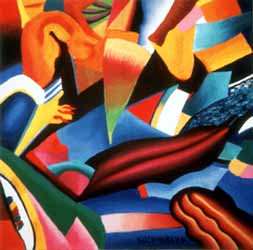
Every artist hopes to create a unique view of the world: Ilona Sochynsky has succeeded. An artist with an intensely personal vision, her work is strong and intriguing with haunting, obsessive images. Her paintings take on their most original, personal character when she juxtaposes realism and abstraction.
Her quiet unassuming persona, particularly when discussing her own work, is not reflected in her paintings, which show strength of character and presence of mind. She reconstructs an inner reality in her pictures and invites the viewer to step into it. Over the last decade, Sochynsky’s work has progressed from photo realism, through abstraction and elements of surrealism. The paintings are executed in a very clean, hard edge manner; the handling of oils is accomplished, with smooth-surfaced, uniform application.
Sochynsky’s work belies the prejudice that painting is dead and that academic training hinders creativity. Her technical virtuosity and evocative images would be impossible without sound academic discipline and tradition.
Images collide, intertwine, abut, overshadow, obscure, and enhance each other. In her early work, Self Portrait with Hairbrush (1982) and Petro is Space (1983) for example, she places human figures and abstract objects in juxtaposition with often surprising, always arresting effect. With their air of vague unreality and myth, the objects depict the artist’s attempt to amalgamate the animate and inanimate worlds. She contrast s softly molded flesh against hard edged colors and contours in the background.
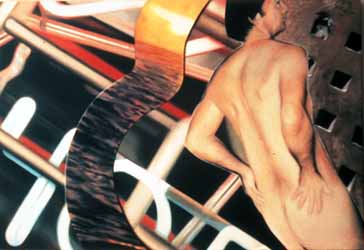
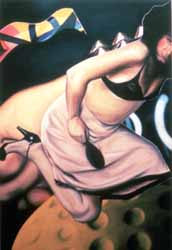
In her more recent painting, the narrative aspect is somewhat diffused by the further fragmentation of images and elimination of figures. More mysterious origins lend a haunting quality. Her work often feels pieced together, not constructed on multiple planes. By altering levels of focus, by varying placement of the images, and by giving inanimate objects what she calls a symbolic “human attribute” Sochynsky replaces the human figures in her paintings with objects.
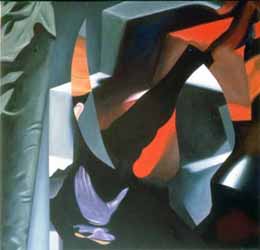
A painting such as Purple Glove (1986) is a good example of this. Fragmentary glimpses of her reality give us perspective on a world which sometimes contains realistic space, sometimes imaginary space, and which included the two on jagged and overlapping planes. Forms float and give off an erriness that redefines their purpose. The real world meets her world, and scale loses all sense of recognizable proportion. Shapes takes on a meaning of their own, and the few literal images, like the glove, take on a new weight and significance.
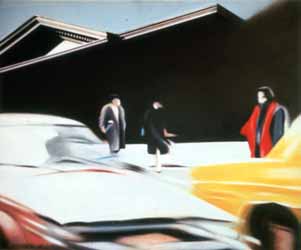
Sochynsky alters levels of focus and placement of images in Coversation (1987), where she has stripped her images to its bare essential. In capturing a specific moment in time, she makes generalizations and at the same time is very precise. She focuses on her principal image and reinforces its dominance by setting it on a dark dramatic background, while making it’s surroundings a blur of oncoming traffic. Yet, detail like dental molding on the building behind the figures is carefully considered. The figures are given precisely the amount of gesture needed to indicate the moment of conversation.
Her work is unified by the perpetual reference to figuration – one of the underlying thrusts in her paintings. Her journey is marked by the exploration of subject from a close vantage point which leads to further abstraction. This absorption with distance from her subject emerges as a study of particular moments in conjunction with jumbled images, much like one would imagine in a situation of simultaneous thoughts and events. The mind is given opportunity to sort these images and make new connections and interpretations.
In her most recent paintings, the remaining figurative images — without which the artist says she could not paint — have taken on a more stylized, flatter presence. In Metropolitan Night (1990) and Landscape with a White Cloud (1990), she creates less volumetric forms with a different treatment of light in the painting, so that the painting is less dramatic, more playful and elegant. Shapes emerge from one another without the forced cropping that was evident in earlier works — as though her shapes are finding their place.
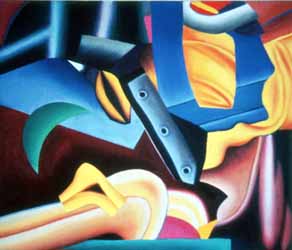
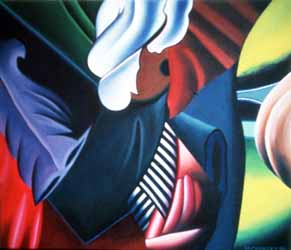
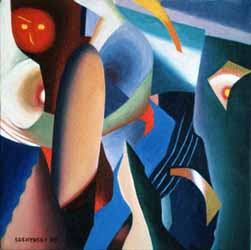
No longer is there a sense of looking at pieces of things. The color is more felt to the particular occasion, not so brash. A cubist reference appears in her use of denser, flatter yet modeled geometric depiction. Her compositions are crammed with information, characters, sometimes in slightly jarring relationships. Sometimes, there is a feeling of a colorful explosion. In Kaleidoscope (1991), there is a joy that is unleashed in this packed multi-textured painting.
The progression of her most recent series of paintings presents a repetition of simple recurring shapes — she is developing her own undeciphered mythology.

